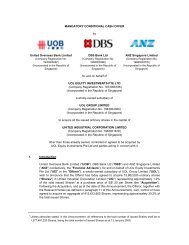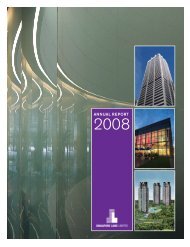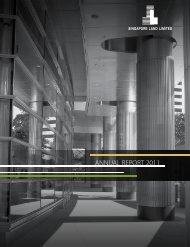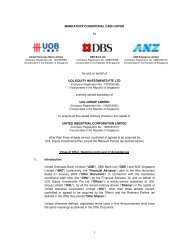Annual Report 2012 - singapore land limited
Annual Report 2012 - singapore land limited
Annual Report 2012 - singapore land limited
Create successful ePaper yourself
Turn your PDF publications into a flip-book with our unique Google optimized e-Paper software.
56<br />
Singapore Land Limited - <strong>Annual</strong> <strong>Report</strong> <strong>2012</strong><br />
NOTES TO THE FINANCIAL STATEMENTS<br />
For the fi nancial year ended 31 December <strong>2012</strong><br />
2. SIGNIFICANT ACCOUNTING POLICIES (continued)<br />
2.10 Impairment of non-financial assets<br />
(a)<br />
Goodwill<br />
Goodwill recognised separately as an intangible asset is tested for impairment annually and whenever there is<br />
indication that the goodwill may be impaired.<br />
For the purpose of impairment testing of goodwill, goodwill is allocated to each of the Group’s cash-generatingunits<br />
(“CGU”) expected to benefi t from synergies arising from the business combination.<br />
An impairment loss is recognised when the carrying amount of a CGU, including the goodwill, exceeds the<br />
recoverable amount of the CGU. The recoverable amount of a CGU is the higher of the CGU’s fair value less<br />
cost to sell and value-in-use.<br />
The total impairment loss of a CGU is allocated fi rst to reduce the carrying amount of goodwill allocated to<br />
the CGU and then to the other assets of the CGU pro-rata on the basis of the carrying amount of each asset<br />
in the CGU.<br />
An impairment loss on goodwill is recognised as an expense and is not reversed in a subsequent period.<br />
(b)<br />
Intangible assets<br />
Property, plant and equipment<br />
Investments in subsidiary and associated companies, and joint ventures<br />
Intangible assets, property, plant and equipment and investments in subsidiary and associated companies,<br />
and joint ventures are tested for impairment whenever there is any objective evidence or indication that these<br />
assets may be impaired.<br />
For the purpose of impairment testing, the recoverable amount (i.e. the higher of the fair value less cost to<br />
sell and the value-in-use) is determined on an individual asset basis unless the asset does not generate cash<br />
infl ows that are largely independent of those from other assets. If this is the case, the recoverable amount is<br />
determined for the CGU to which the asset belongs.<br />
If the recoverable amount of the asset (or CGU) is estimated to be less than its carrying amount, the carrying<br />
amount of the asset (or CGU) is reduced to its recoverable amount.<br />
The difference between the carrying amount and recoverable amount is recognised as an impairment loss in<br />
the income statement, unless the asset is carried at revalued amount, in which case, such impairment loss is<br />
treated as a revaluation decrease.










